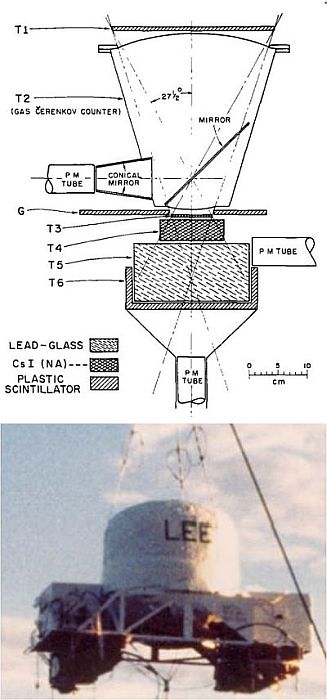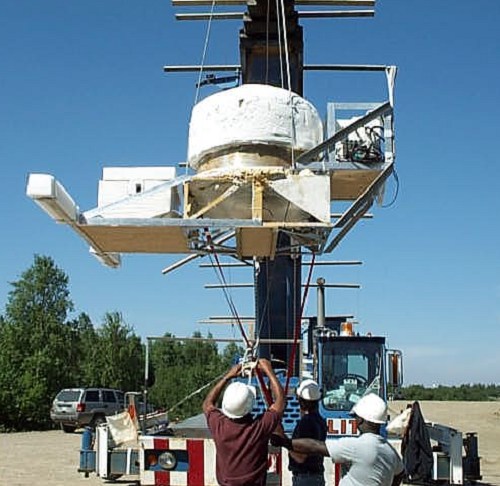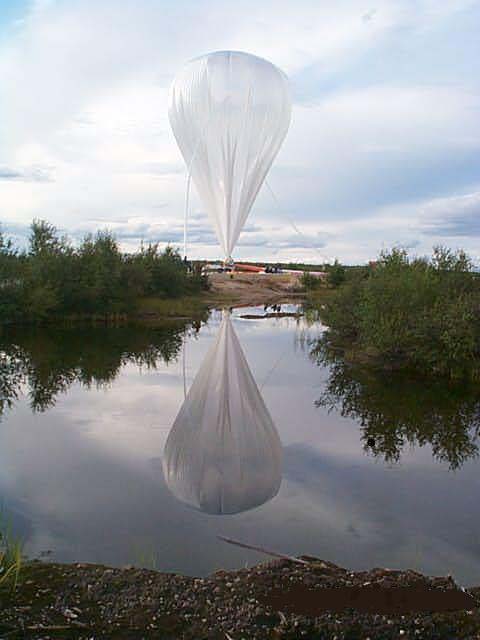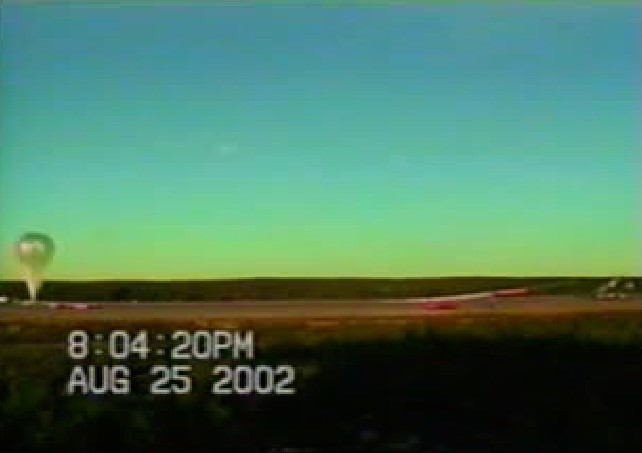Purpose of the flight and payload description
LEE (Low Energy Electron) was an instrument created to measure the energy spectrum of cosmic ray electrons. It was developed in the late 1960's decade at the University of Chicago. Regular balloon flights have been made from Northern Canada every year from 1968 to 1975 and approximately bi-annually until 1979. Then, the experiment was transfered to the University of Delaware, wich now operates it. The observations from LEE provided the scientific community with one of the more precise measurements of the electron spectrum over a period of time of more than 50 years.
In the picture at left we can see a basic scheme of LEE and the instrument ready to flight on its gondola. The design remained intact since its inception with only minor upgrades made periodically. It consisted of a counter telescope made of NE 102 A plastic scintillators, a CsI(T1) scintillator, a gas Cerenkov counter, a lead glass Cerenkov counter, and a plastic penetration counter. Basically, the LEE instrument measured electron energies by causing incoming electrons to shower and recording the resulting signals from the shower counters. The maximum angle of acceptance was 27.5° from vertical, and the geometry factor was 18 cm2 sterad, defined by the two plastic scintillators T1 and T3. These two counters had diameters of 28 cm and 7 cm and thicknesses of 0.5 cm and 0.32 cm respectively. The gas Cerenkov counter T2 consisted of a conical container filled with Freon 12 at 2.5 atmospheres of pressure. The T1, T2, T3 coincidence was used to initiate the measuring process for each event.
Located under this telescope were a CsI counter (T4) of a thickness corresponding to 2 radiation lengths and a lead glass Cerenkov counter (T5), 6.7 radiation lengths thick. Particles entering the telescope were either absorbed or, together with their secondaries, penetrated the plastic cup counter T6. The reason for introducing two separate counters T4 and T5 was that this separation permited distinguishing electrons from interacting protons at high energies, and that counter T4 provided good energy resolution for electrons at low energies.
The output of counter T6 served as an additional parameter for energy determination in those cases where the energy of the initiating electron was sufficiently high that the shower penetrated T5. The output from T6 yielded the number of penetrating shower particles. The addition of a guard counter G, whose firing in coincidence with the master pulse T1 T2 T3 was indicated, served to identify events which were triggered by showers initltated above and around the apparatus. It also rejected events in which secondary particles entered the window of the gas counter photomultiplier leading to a false triggering of T2 by Cerenkov light produced in the window material. For each event, pulse heights were measured from counters T3, T4, T5 and T6 by 256 channel analyzers. The information on rates and pulse heights was digitized by the electronics system and recorded by an on-board magnetic tape recorder as well as telemetered to the ground.
The entire system was housed in an aluminum shell and kept under atmospheric pressure during the balloon flight. The weight of the instrument in its shell and including batteries amounted to approximately 400 lb.
The Ultra-High Altitude Balloon (UHAB)
Besides the scientific instrument described above, this flight was mainly focused on testing a new balloon of a kind known as Ultra-High Altitude Balloon (UHAB). These vehicles allow to take payloads approaching 900-1,000 kg to altitudes in excess of 45 km using traditional zero-pressure designs.
In addition to providing unprecedented altitudes from which to make scientific observations, the UHAB also opens new avenues for long duration ballooning at mid-latitudes. With altitude excursions of 10-12 km, these balloons will be able to execute long duration flights without the need for large quantities of ballast. If augmented by a small superpressure anchor balloon, the altitude excursions could be kept to a minimum. While not as capable as the ULDB in carrying large payloads, the UHAB would add another capability for scientists with relatively light payloads who desire to maximize mission time and altitude.
The development started in March, 2002, when NASA requested that Raven Industries perform a study on a series of ultra-high altitude zero pressure balloon platforms. After analyzing several load-altitude targets, NASA chose a 1.7 million cubic meter (60 million cubic feet) design with an ultimate payload capacity of 750 kg. While the balloon was designed using traditional zero-pressure techniques, the shell and cap material was chosen to be Stratofilm-430 (which was based upon the Stratofilm-420 developed for the ULDB program) a three-layer co-extruded film using the same resins as Stratofilm-420. The total film thickness is 10.2µ for the shell and 13.2µ for each of the two cap layers. Compared to traditional zeropressure balloon film, the Stratofilm-430 has higher strength and ductility at normal surface temperatures, making the shell better able to withstand dynamic launch loads.
Production of the balloon, unofficially christened the "BIG 60", required some minor rearrangement of production space to accommodate the almost 230 meter gore length. Fabrication of the balloon was relatively straightforward and uneventful due to its similarity to standard zeropressure designs. Because of the delicate film, special considerations were made for the processes of expelling excess air and loading the balloon.
The first test conducted during the summer 2002 campaign at Lynn Lake was uneventfull. After a successfull launch the balloon climbed to a peak altitude of 49.4 km, and was terminated normally after approximately 23 hours of flight time. This was the largest balloon ever successfully flown, setting a new world record that remained unbeated since 1975.
Details of the balloon flight
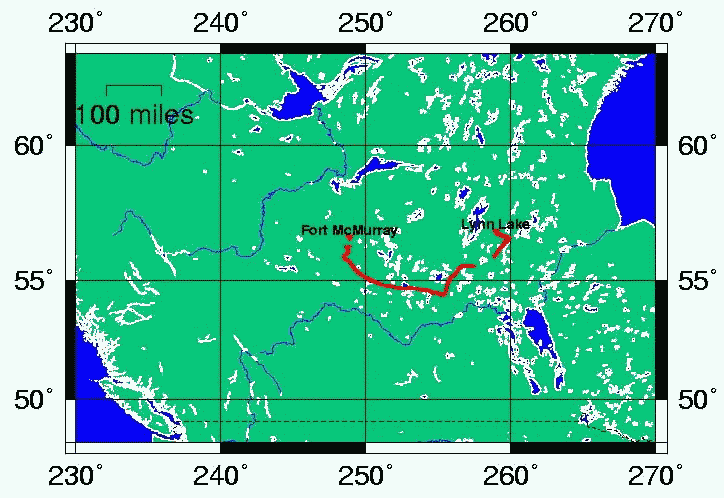
Balloon launched on: 8/25/2002 at 1:05 utc
Launch site: Lynn Lake Airport, Manitoba, Canada
Balloon launched by: National Scientific Balloon Facility (NSBF)
Balloon manufacturer/size/composition: Zero Pressure Balloon Raven Big 60 - 1.700.000 m3 - SF4-59.84-.4/.52/.52-NAR
Balloon serial number: R59.84-2-01
Flight identification number: 508N
End of flight (L for landing time, W for last contact, otherwise termination time): 8/26/2002 at 22:31 utc
Balloon flight duration (F: time at float only, otherwise total flight time in d:days / h:hours or m:minutes - ): 22 h 15 m
Landing site: 8 miles SSW of Anzac, Alberta, Canada
Payload weight: 1546 lbs
The balloon was launched by dynamic method assisted by a launch crane on August 25th.
After a nominal ascent phase the balloon reached the float altitude of 49.4 km and started a flight path due to the west as can be seen in the map at left (click to enlarge).
During the flight the balloon mantained a flight level of ~ 49 km until after near 23 hours of flight it was terminated.
The payload landed near the city of Fort McMurray, in Alberta, Canada.
External references
- AESOP / LEE web site Bartol Research Institute
- A detector system for cosmic ray electrons Nuclear Instruments and Methods, 85(1), Pag. 93, 1970
- Extended Capabilities of Zero-pressure and Superpressure Scientific Ballooning Platforms AIAA's 3rd Annual Aviation Technology, Integration, and Operations (ATIO) Forum, 2003
- NASA Scientific Balloon Sets World Record NASA press release
- Record-setting balloon skirts edge of space CNN Space
- Ultra high altitude balloons for medium-to-large payloads Advances in Space Research, Volume 33, Issue 10, p. 1648
2294If you consider this website interesting or useful, you can help me to keep it up and running with a small donation to cover the operational costs. Just the equivalent of the price of a cup of coffee helps a lot.

